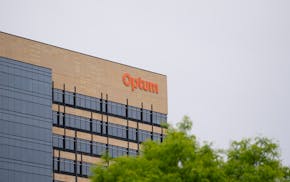At a critical moment, Minnesota's economic development efforts have a new leader.
Matt Varilek will lead the Department of Employment and Economic Development (DEED) as employers are dealing with crisis-level labor shortages, and consumers are anxiously waiting as central bankers attempt to cool inflation to avoid a recession. Meanwhile, lawmakers recently loaded his agency with more cash and responsibilities, including running the massive — and controversial — paid family and medical leave program.
"As the Fed sets policy that impacts the national waters that we swim in, we're trying to make sure that Minnesota is making the most of our resources so that this is an attractive place for workers," Varilek said. "I feel like the customers of this agency are all of Minnesota."
The 48-year-old father of three came to DEED from the Little Falls-based Initiative Foundation, where he led an organization that uses loans, grants and other financing to bolster central Minnesota's regional economy and communities.
He previously served as chief operating officer of the U.S. Small Business Administration and was economic development director for former Democratic U.S. Sen. Tim Johnson, of South Dakota. Varilek, who grew up in South Dakota, made an unsuccessful bid for Congress there about a decade ago.
One month into the job, Varilek spoke with the Star Tribune about Minnesota's economic development needs. The following has been edited for length and clarity.
How have your past roles and political experience prepared you for this job and shaped your approach at DEED?
I made the case as a candidate that serving at a large economic development agency like the Small Business Administration would be analogous to the responsibilities of leading our state's primary economic development and workforce development agency.
In addition, spending 6½ years at the Initiative Foundation in Little Falls and serving the 14 counties and two Native nations there with programs like small business lending, with entrepreneurial training, workforce development, childcare efforts and beyond, those experiences helped to ground me in the reality of Minnesota economic development and workforce development.
What are the biggest roadblocks to economic growth in Minnesota?
The central feature of the economic landscape in Minnesota right now is the challenge with workforce development and workforce availability, talent. Fortunately, with advocacy from the governor, lieutenant governor and others — and with the circumstances of the last legislative session — we now have resources to address those challenges on a scale that we have not had before.
Now with very low unemployment, it's a significant challenge even with those resources. But we have programs with a track record of success, and now we can scale them in a way that I'm optimistic is going to help bring more young people and more people who just haven't found the right career path into the workforce to meet the needs of employers.
What are the most important steps Minnesota can take to attract and retain businesses?
There are numerous factors that a business wants to take into consideration when they're deciding where to start, where to stay, where to expand. And we need to keep all those plates spinning at the same time. They need to have an appropriate site. They need to have access to infrastructure. They need to have access to their customers, to the supplies that they will use to produce their goods or services.
They need to have access to talent. And that's the one where we're really competing with lots of other places right now, and where I feel like the investments that have been made and that we're in the process of delivering — through grants and resources to other partners — are really going to make a difference and help us to stand out.
What is happening now to implement the paid family and medical leave program, and how will you find the roughly 400 employees needed to run it?
January of 2026 is when benefits start becoming available and when we start collecting premiums from employers and from workers. But in the meantime, there's plenty of work that needs to happen here. One of the first deadlines we have is to produce an actuarial study that will give us a more precise estimate of the economics of the program. And so that's underway.
We're also in the process of making some of the early hires, and they will help us to flesh out in more detail the precise step-by-step process of standing up a brand new program.
We now want to hear from everyone who's going to be impacted by this program about the implementation piece, so that we can make it work for all. We will be looking for input from lots of folks, including the business community, workers and others to make sure that we can just deliver this as professionally and effectively as possible.
Affordable housing and child care access remain two of Minnesota's biggest workforce challenges. How is DEED working with public and private sector partners on those shortages?
When it comes to housing, we have some resources there that we use directly. But to a greater extent, of course, that's Minnesota Housing with Commissioner Jennifer Ho who has responsibility there. So lots of interagency collaboration to make sure that we are all rowing in the same direction. And she has pointed out that they have an extraordinary and historic level of investment that they are looking to deliver efficiently.
When it comes to child care, we have a new Office of Child Care Partnerships that will be stood up to help unify and optimize the various resources that we have. Child care is a challenge almost everywhere, but the solutions are not uniform. And so you need to tailor it to the particulars of the location.
Increasingly, this is a topic that is no longer just the domain of early educators. Now bankers care about it, manufacturers care about it. And so when we can be a provider of resources to enable collaboration by parties like that, that's when I think we can start to see success.
A recession appears increasingly unlikely, but how might the state's economy fare if we face a potential downturn?
We have more and more reasons for optimism looking forward. Nevertheless, the fact that the Legislature invested significant resources across a variety of agencies, not just over one year but across the biennium, means we will have what you could regard as fiscal stimulus coming into the system. So if we see a downturn in economic activity, I'm hopeful that many of the programs that we now have to deploy will blunt some of that negative impact.
What will marijuana legalization mean for job growth in Minnesota?
It's going to open up a new industry with entrepreneurial opportunities for people to start up and explore what kinds of business models make sense. There's a regulatory component of this that is outside of DEED, but in the same way that we want to support entrepreneurs in other sectors, we will then help to support entrepreneurs in this sector.
We can't say with any certainty how the industry will look, in terms of whether we'll have a lot of concentration in a few companies or we'll have a whole bunch of smaller retail providers. But our job will be to help people get off the ground.
Looking out a decade or two, what do you see as Minnesota's biggest economic challenges, and what can you do now to prepare for them?
We want to grow this economy so that we have more prosperity in general. We want the pie to be bigger, and we would like that prosperity to be broadly shared. When there are individuals who have been historically marginalized — whether due to race, whether due to economic circumstances, whether due to disability or age — that's where we want to target our efforts so that the folks that aren't yet enjoying Minnesota prosperity can join those who are.

Minnesota factories see orders tank on continued trade uncertainty
'We don't want to lose this mine': Fear sets in for Iron Range miners as shutdown takes hold

UnitedHealth sues the Guardian, alleging defamation in coverage of nursing home care

